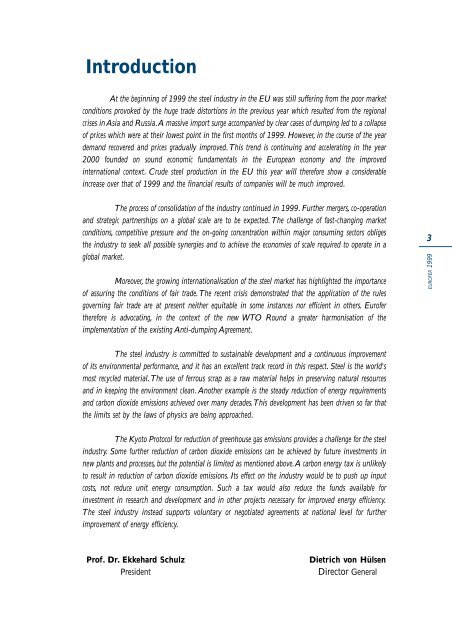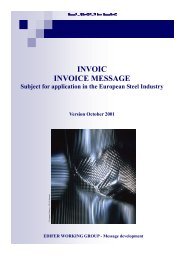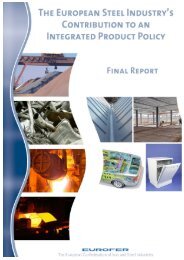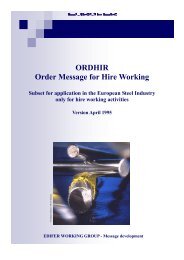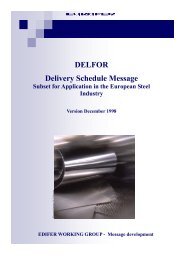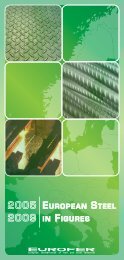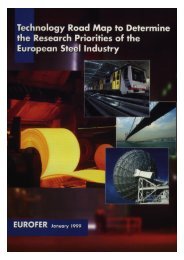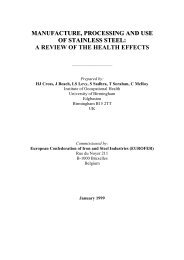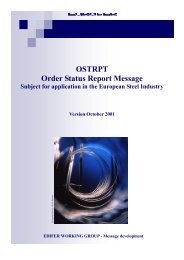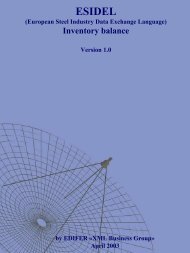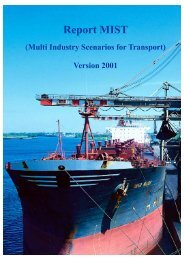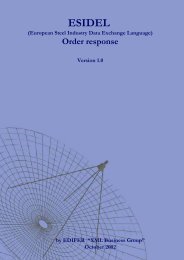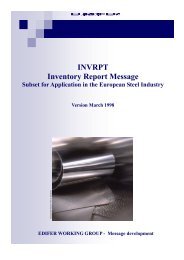Steel Market - Eurofer
Steel Market - Eurofer
Steel Market - Eurofer
Create successful ePaper yourself
Turn your PDF publications into a flip-book with our unique Google optimized e-Paper software.
Introduction<br />
At the beginning of 1999 the steel industry in the EU was still suffering from the poor market<br />
conditions provoked by the huge trade distortions in the previous year which resulted from the regional<br />
crises in Asia and Russia.A massive import surge accompanied by clear cases of dumping led to a collapse<br />
of prices which were at their lowest point in the first months of 1999. However, in the course of the year<br />
demand recovered and prices gradually improved.This trend is continuing and accelerating in the year<br />
2000 founded on sound economic fundamentals in the European economy and the improved<br />
international context. Crude steel production in the EU this year will therefore show a considerable<br />
increase over that of 1999 and the financial results of companies will be much improved.<br />
The process of consolidation of the industry continued in 1999. Further mergers, co-operation<br />
and strategic partnerships on a global scale are to be expected.The challenge of fast-changing market<br />
conditions, competitive pressure and the on-going concentration within major consuming sectors obliges<br />
the industry to seek all possible synergies and to achieve the economies of scale required to operate in a<br />
global market.<br />
Moreover, the growing internationalisation of the steel market has highlighted the importance<br />
of assuring the conditions of fair trade.The recent crisis demonstrated that the application of the rules<br />
governing fair trade are at present neither equitable in some instances nor efficient in others. <strong>Eurofer</strong><br />
therefore is advocating, in the context of the new WTO Round a greater harmonisation of the<br />
implementation of the existing Anti-dumping Agreement.<br />
The steel industry is committed to sustainable development and a continuous improvement<br />
of its environmental performance, and it has an excellent track record in this respect. <strong>Steel</strong> is the world's<br />
most recycled material.The use of ferrous scrap as a raw material helps in preserving natural resources<br />
and in keeping the environment clean. Another example is the steady reduction of energy requirements<br />
and carbon dioxide emissions achieved over many decades.This development has been driven so far that<br />
the limits set by the laws of physics are being approached.<br />
The Kyoto Protocol for reduction of greenhouse gas emissions provides a challenge for the steel<br />
industry. Some further reduction of carbon dioxide emissions can be achieved by future investments in<br />
new plants and processes, but the potential is limited as mentioned above.A carbon energy tax is unlikely<br />
to result in reduction of carbon dioxide emissions. Its effect on the industry would be to push up input<br />
costs, not reduce unit energy consumption. Such a tax would also reduce the funds available for<br />
investment in research and development and in other projects necessary for improved energy efficiency.<br />
The steel industry instead supports voluntary or negotiated agreements at national level for further<br />
improvement of energy efficiency.<br />
Prof. Dr. Ekkehard Schulz<br />
President<br />
Dietrich von Hülsen<br />
Director General<br />
3<br />
EUROFER 1999


